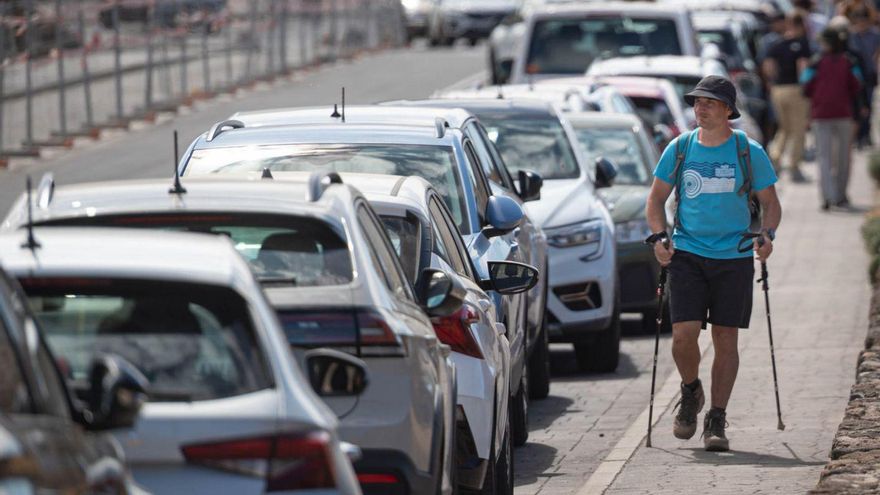A Deferred Decision for Teide’s Protection
The Canary Islands Government has passed the responsibility for major decisions needed to protect Teide—such as banning private cars—to the Tenerife Island Council (Cabildo de Tenerife). The new Draft Management Plan (PRUG) for the Tenerife national park, which will replace the 23-year-old current plan, barely scratches the surface of the measures required by Europe’s most visited protected area. With 5.2 million visitors in 2024, the park’s fragile ecosystems face one primary threat: overcrowding from tourists and vehicles.
The Basics of the New Management Plan
The final draft, recently agreed upon by both administrations (governed by CC and PP) and set to be debated by the park’s advisory board next Monday, establishes only very basic guidelines for access and transit within its 189 square kilometers. This is a far cry from the previous draft developed under the last mandate by a PSOE-led Canarian government, which proposed three major transport hubs at the park’s gates—El Portillo, Vilaflor, and Chío—where visitors would leave their vehicles and continue on public buses.
The Vague Promise of Sustainable Mobility
The new plan states that “the sustainable mobility system will be the subject of a specific action programme” to be developed by the Tenerife Island Council, “taking into account access roads and visitor influx by time slots.” In broad terms, the PRUG only proposes “dissuasive parking areas outside the national park combined with bus and/or shuttle services to access” the natural monument and “the promotion of public transport use.” It does not detail, for example, where these parking areas would be located.
Shuttle Buses and Limited Parking Restrictions
Regarding the “public or private” shuttle buses that would operate within Teide, the plan specifies they will have seven stops and new lay-bys to facilitate the movement of these collective transport vehicles. These seven stops will be at points of major interest within the UNESCO World Heritage site that also have parking: La Ruleta, Cañada Blanca, the Juan Évora Ethnographic Museum, Minas de San José, the Cable Car, Portillo Alto, and the El Portillo Visitor Centre.
The only limitation on the use of private cars, motorbikes, and vans concerns parking, not transit through the entire park. The document states that, “during the operating hours of the sustainable mobility system, access to parking areas will generally be prohibited for any vehicle that is not for public or private collective transport (buses).” Exceptions are made for national park staff, companies contracted by the managing administration, public administrations with sectoral competencies in the park, security forces, traditional land uses, research work, and duly authorised activities.
Road Access Remains Unrestricted for Now
Any further measure that involves restricting private vehicles and prioritising public transport—which could end the chaos that reigns at the summit of Spain and has generated so many complaints from community groups—will depend on the mobility instrument that the Cabildo must draft once this new PRUG is definitively approved. For example, regarding traffic on the three roads that cross the domain of Guayota (the mythical abode of the volcano), the PRUG notes: “Circulation on the TF-21, TF-24, or TF-38 roads is free for any type of vehicle and is subject to the determinations of the Tenerife Island Council and specific traffic and road safety regulations.”
Behind the Scenes: Ambitious Ideas and Practical Hurdles
The island government agrees with the regional government in rejecting the three large interchanges planned by the previous PRUG, drafted by the Ministry of Ecological Transition under socialist José Antonio Valbuena. They argue that even though they would have been at the park’s gates, they would have had a significant impact on a territory highly sensitive to any alteration. However, some island departments, such as Natural Environment, had hoped the document modified by Ecological Transition would be more ambitious regarding the need for improved protection measures.
Aware that they must develop a specific sustainable mobility plan, technicians from the island’s Natural Environment department have been working for months on a proposal that would establish drastic restrictions on the entry of private vehicles and give maximum priority to collective transport. The idea is to close the three road accesses to cars and have visitors travel through the Las Cañadas caldera on the park’s own buses—similar to the Timanfaya model in Lanzarote—picking them up at the destination, i.e., at the existing interchanges in the Metropolitan, North, and South areas.
The Challenge of Closing Insular Roads
One major obstacle is the fact that the TF-21, TF-24, and TF-38 are insular roads, meaning they could not be closed. Technicians are working on the premise of removing this “insular” designation to make it possible to close them for environmental protection reasons. This is supported by the fact that almost no one uses these roads to cross from the north to the south of the island anymore, as they did before the construction of the Insular Ring road.
In any case, this closure to private cars, motorbikes, and vans would be subject to exceptions, which are currently being studied. One option involves establishing time slots dependent on peak visitor numbers. What is clear is that people who work in the national park, security and emergency teams, those with authorised beehives and other traditional uses, those with permits for sports activities, or researchers studying Teide’s biodiversity or geology will be able to access with their vehicles, whether private or collective. There will also be an exception regime for residents of Tenerife, who will not have to pay for the internal bus circuit, unlike tourists.

